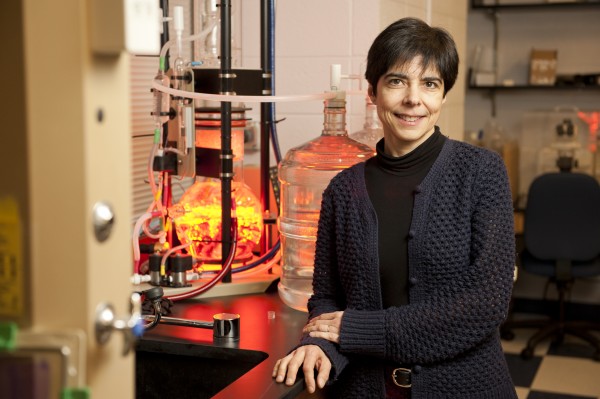From protein signaling to cancer drug development

Living organisms depend on proteins for their survival. These large, complex molecules mediate nearly every life function, but when the genes that code for them start to mutate, those functions begin to break down.
For example, nearly 30 percent of all cancers are mediated by mutations in a protein called RAS, which is the primary molecule of interest in the lab of Carla Mattos, a newly appointed professor of chemistry in the College of Science. Up until now, “RAS has been completely elusive as a drug target,” she said.
A member of a larger class of proteins called GTPases, RAS promotes cellular proliferation when it is bound to a molecule called guanosine triphosphate, or GTP.
Once bound, RAS can interact with other proteins called effector proteins, one of which is another three-letter protein called RAF. This sets off a cascade of other molecular interactions that allows the cell to reproduce itself. This cellular proliferation doesn’t stop until RAS promotes the hydrolysis of GTP to GDP (guanosine diphosphate).
For decades, scientists thought the only way to control this signaling process, and subsequently shut down proliferation, was through yet another protein called GAP. When bound to RAS, GAP acts like an off switch by speeding up hydrolysis.
But several mysteries remained. For one, a genetic mutation that makes RAS insensitive to GAP doesn’t result in cancer. This is surprising because cancer is defined by unchecked cellular proliferation. In this case, the traditionally understood GAP-mediated off switch doesn’t work, and yet the process still finds a way to shut down.
Two years ago, Mattos’ lab discovered a new mechanism for turning off RAS that is mediated by something called an “allosteric,” or remote, binding site on the protein. When something binds there, RAS’ structure changes, including the part that normally interacts with GAP.
This new conformation, stabilized in the presence of RAF and the activated allosteric site, is thought to promote hydrolysis of GTP in the absence of GAP and turn off the RAS signal for cell proliferation. No one had suspected the existence of the alternate mechanism until Mattos’ results were reported in 2010.
Backed by the support of a new a three–year, $800,000 grant from the National Science Foundation, Mattos and members of her research team will start to tease out the nuances of this alternative mechanism. First on the list of things to do is identify what molecule binds at the allosteric site. “We don’t know what the ligand is yet, but we think it’s a membrane component,” said Mattos. This theory is supported by the fact that RAS does most of its work when it’s attached to a cell’s inside wall.
If the researchers can understand this novel mechanism for turning off RAS, they could provide a new paradigm for cancer drug development. “Our group is proposing that we should be targeting these other sites close to the membrane,” said Mattos. “If we interrupt this conversation between RAS and the membrane interface, we’re also going to be disrupting signaling.”





